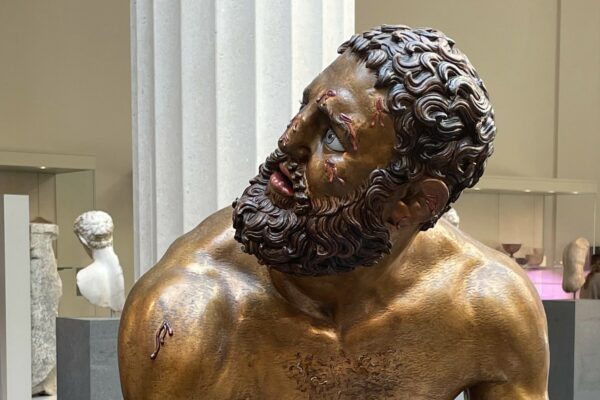
What could go wrong with this idea?
Episode 69: In which the architects of the Parthenon and Stonehenge discuss new shapes and new chauvinistic cultural assumptions.
This episode of Real Housewives of Hades (a Mt. Olympus spin-off) brought to you by the latest archaeological news on CNN.com and SmithsonianMagazine.com – and by our upcoming archaeological lecture on September 25.
[SETTING: Underworld Club for Architects]
PHIDIAS, DESIGNER OF THE PARTHENON: Connacht, you seem upset. What’s wrong?
CONNACHT, DESIGNER OF STONEHENGE: Ugh, I was just reading the mortal newspapers. Apparently mortals have found the world’s earliest known architectural blueprints. And they’re for large-scale architectural constructions that pre-date my Stonehenge by about 5,000 years!
PHIDIAS: And that’s a bad thing?
CONNACHT: I don’t know, I’ve kind of gotten used to being the major mysterious prehistoric architect that mortals are still wondering about millennia later. “How did they build Stonehenge?” “Why did they build Stonehenge?” “What sort of primitive societies could organize themselves to create such a monument to the human spirit?”
PHIDIAS: Didn’t you say it was actually an offal restaurant?
CONNACHT: Yes. But the modern mortals don’t know that yet.
PHIDIAS: I still don’t see what the problem is.
CONNACHT: If I’m being honest, I guess I’m having trouble sharing the spotlight. Mortals have been studying these massive constructions in the Middle East and Central Asia for awhile now, especially once they started flying chariots across the sky and taking pictures. I have to admit, the constructions are pretty impressive. They date to about 8,000 years ago, and they could run several kilometers in length. Mortals think they were used to funnel big herds of game animals together. And now they’ve discovered architectural plans for designing these things! Plans that are to-scale!

Section C represents the earliest known evidence of Charlie Brown.
PHIDIAS: Huh, I’ve never even heard of this monument. What is it called? The Middle-Eastern Stonehenge?
CONNACHT: Thank the gods, no. And it’s not a single monument. There’s around 6,000 of these things. The mortals call them “kites” because they look vaguely like the shape of a kite when you view them from above like a god.
PHIDIAS: That seems vaguely insulting. Sort of like calling Stonehenge “a circle” and leaving it at that. Are they investigating the symbolism of these kites?
CONNACHT: The mortal news doesn’t say. They seem to just assume they’re animal pens of some sort.
PHIDIAS: So, large prehistoric structures in England are astronomical calendars that represent man’s relationship to the unknown, and large prehistoric structures in the Middle East are animal pens.
CONNACHT: Apparently. At least as far as the mortal news is concerned. But the use of blueprints does imply a concept of abstract representation and engineering that’s pretty impressive for the time.
PHIDIAS: Didn’t you use blueprints to build Stonehenge?
CONNACHT: Not really. It’s just a series of circles. We had someone hold a stick in the center, and then someone else hold a length of rope tied to that stick and walk in a circle around it. Maypoles accomplish basically the same thing. Then we dug a ditch and tipped some rocks in. The final result is impressive but there’s definitely a life hack at the planning stage.

Engineering!
PHIDIAS: But why did you import bluestones from hundreds of miles away?
CONNACHT: Oh, those were just lying around from a previous monument. Up-cycling keeps construction costs down.
Share on Instagram, or really wherever you want.
To learn more about desert kites and their amazing architectural achievements, join us for our upcoming lecture “Desert Kites–The Enigmatic Traps from the Air and on the Ground” by Dr. Yorke Rowan (University of Chicago), on Sept 25, 7:30 PM. Or to explore more about ancient engineering (and how there’s usually a hack), look for CLAS-C 414 Art and Archaeology of the Roman World, coming in Spring 2024 with no pre-reqs. While you’re waiting, make sure to check back for more adventures of Phidias and Connacht in the Underworld Club for Architects. Can’t get enough of Ancient Greece and Rome? Earn a Classics Minor in just 15 credits!


